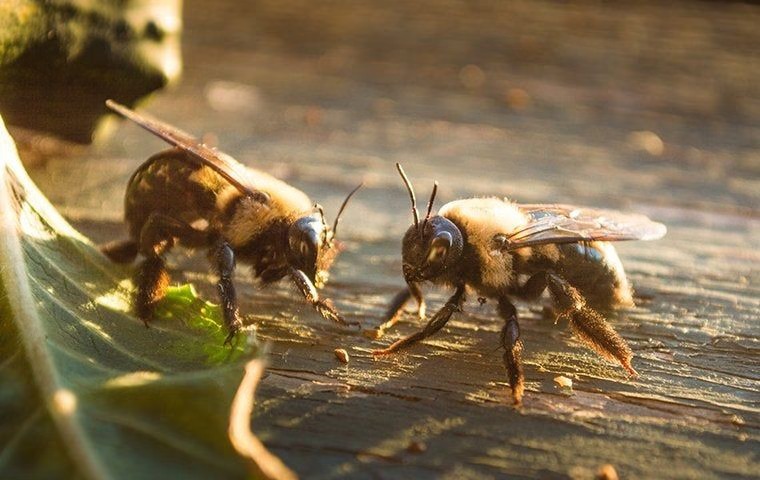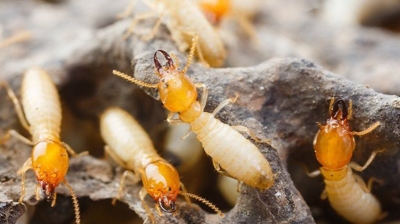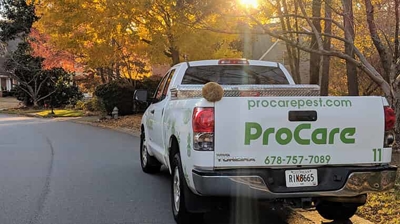
Stinging Insect Identification & Prevention

Stinging Insects In Georgia
Many stinging insects are often confused with each other, and although this may not seem like a big deal, misidentification can make eliminating them more challenging. Find out all about the different stinging insects in our area here and discover a home pest control plan that works for you.
Frequently Asked Questions About Stinging Insects
Have questions? We are here to help. Still have questions or can't find the answer you need? Give us a call at 678-757-7089 today!
-
What are stinging insects?
Wasps, yellow jackets, and carpenter bees are some of the stinging insects we see most in our area. Yellow jackets are highly territorial and often sting people who unknowingly get too close to their nest, especially during yard work.
At the same time, carpenter bees are wood-damaging pests. They don't eat wood but bore into it to create their nests. Also, carpenter bees are solitary, meaning they don't live with a colony like yellow jackets.
-
Are stinging insects dangerous?
Stinging insects can be dangerous, but it is often situational and depends on the type of pest and other factors. Here are a few things you should know:
- Most stinging insects only sting when they feel threatened.
- Social species are more aggressive than solitary because they have to protect their colony and queen, so carpenter bees are less dangerous than wasps and yellow jackets.
- Male carpenter bees can't sting.
- Yellow jackets are more aggressive than other wasps.
- Unlike honey bees, which have a barbed stinger, wasps, yellow jackets, and carpenter bees have smooth stingers, which means they can sting multiple times.
- Children and animals are more susceptible to a sting from one of these pests because they are more likely to disturb a nest accidentally.
- Some people are allergic to these pests and will experience a more severe reaction.
In general, it's best to keep your distance from stinging insects to avoid a sting.
-
Why do I have a stinging insect problem?
Food is one of the most attractive factors for any pest, including stinging insects. While carpenter bees consume nectar and pollen, wasps and yellow jackets feed on other insects. However, they also eat nectar and pollen, making them important pollinators in the ecosystem.
These pests are also attracted to water sources, so you could attract stinging insects if you have a leak or other moisture issue. And like other pests, these insects look for somewhere safe to build their nests, including ground holes, stumps, dead trees, eaves, and many more similar places.
-
Where will I find stinging insects?
It might seem like stinging insects will find you when you're trying to enjoy your time outside as they are curious pests. However, you can find these insects in places like under decks, rock piles, and inside walls if there are cracks in the home's exterior.
Carpenter bees will bore holes in wood that is damaged or weathered, including furniture, decks, fences, doors, play structures, sheds, and more.

Stay In The Know
-
 How to Tell If There’s Wildlife Activity in Your Home (and What to Do About It)Read More
How to Tell If There’s Wildlife Activity in Your Home (and What to Do About It)Read More -
 Keep Your Atlanta Home Fly-Free: How Procare Manages House Flies, Fruit Flies, and Other Nuisance FliesRead More
Keep Your Atlanta Home Fly-Free: How Procare Manages House Flies, Fruit Flies, and Other Nuisance FliesRead More -
 DIY pest control?Read More
DIY pest control?Read More -
 Procare: The Best Pest Control Solutions for Atlanta BusinessesRead More
Procare: The Best Pest Control Solutions for Atlanta BusinessesRead More -
 3 Signs You Might Have a Termite Problem in Atlanta—and How to Spot Them EarlyRead More
3 Signs You Might Have a Termite Problem in Atlanta—and How to Spot Them EarlyRead More -
 Your Year-Round Defense Against Fall Bugs and Joro Spiders in AtlantaRead More
Your Year-Round Defense Against Fall Bugs and Joro Spiders in AtlantaRead More -
 How To Solve Any Fall Pest issue in 2024Read More
How To Solve Any Fall Pest issue in 2024Read More -
 Keeping Spiders Out Of Your HomeRead More
Keeping Spiders Out Of Your HomeRead More









